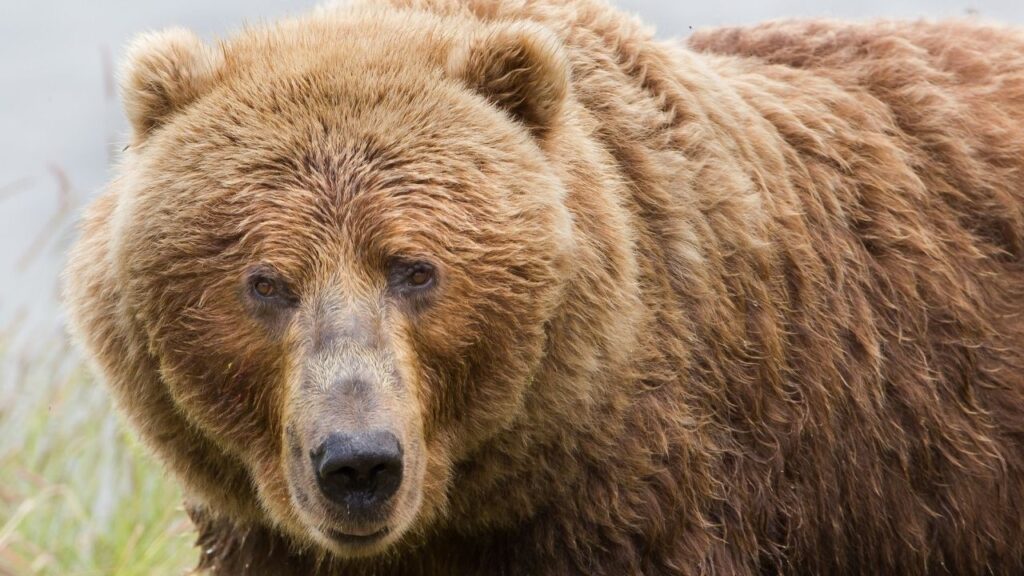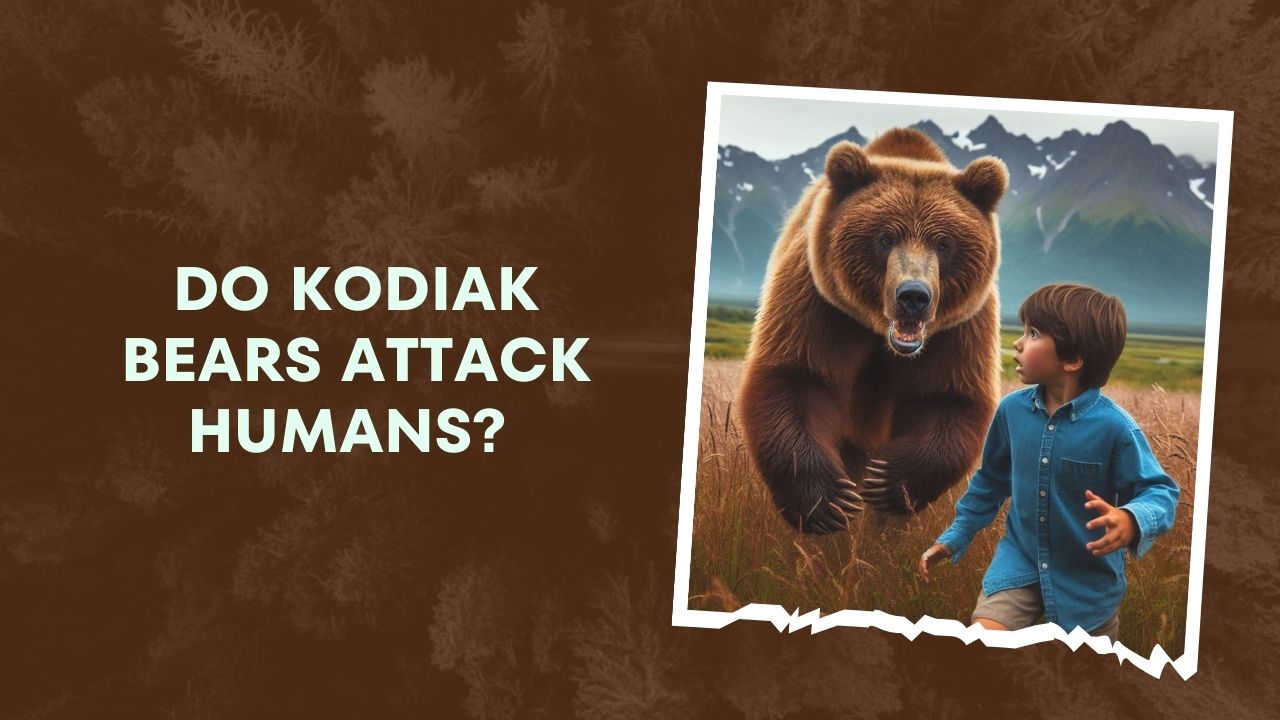Do Kodiak Bears Attack Humans? Kodiak bears are generally not aggressive toward humans but can attack if they feel threatened, especially when protecting cubs or food.
Kodiak bears, one of the largest bear species on Earth, have long fascinated wildlife enthusiasts and adventurers alike. [Do Kodiak Bears Attack Humans?]
Known for their immense size and power, these bears inspire both awe and fear. A common question that arises is: do Kodiak bears attack humans?
While their size and strength suggest they could be formidable opponents, understanding their behavior reveals a more nuanced picture.
This article explores the likelihood of Kodiak bear attacks, the circumstances under which they might occur, and the steps you can take to stay safe in their presence.
Contents
What Are Kodiak Bears?
Physical Characteristics
Kodiak bears (Ursus arctos middendorffi) are a subspecies of the brown bear, and they are endemic to the Kodiak Archipelago in Alaska. [Do Kodiak Bears Attack Humans?]
They are among the largest terrestrial carnivores, with adult males weighing between 800 and 1,500 pounds, and in some cases, even exceeding that.
Females are typically smaller, weighing between 400 and 700 pounds. On their hind legs, adult males can stand over 10 feet tall, giving them an imposing presence.
Their thick, shaggy fur ranges from dark brown to lighter shades of blonde, providing excellent camouflage in the dense forests and tundras of their habitat. [Do Kodiak Bears Attack Humans?]
Their large claws, powerful jaws, and muscular build make them adept hunters and foragers. Despite their massive size, they are surprisingly agile and can run up to 30 miles per hour for short bursts.
Habitat and Behavior
Kodiak bears are found exclusively on the Kodiak Archipelago, which consists of several large and small islands. This isolated environment has allowed them to develop unique behavioral traits.
They inhabit a variety of ecosystems, including coastal areas, dense forests, and alpine meadows.
Their diet is omnivorous and highly seasonal. In spring and early summer, they feed on vegetation, such as grasses and roots.
During the salmon spawning season, fish become a crucial part of their diet, providing the high protein and fat content needed to build up energy reserves for the winter. They also consume berries, nuts, and occasionally small mammals or carrion.
Kodiak bears are solitary animals, except during mating season or when mothers are raising cubs. [Do Kodiak Bears Attack Humans?]
They typically avoid conflict and are known for their relatively docile nature compared to other brown bear subspecies.

Do Kodiak Bears Attack Humans?
Nature of Kodiak Bears
Kodiak bears are generally not aggressive toward humans. Unlike grizzly bears, which are more frequently associated with aggressive behavior, Kodiak bears tend to avoid human contact whenever possible.
Their remote habitat plays a significant role in minimizing human interactions, reducing the likelihood of conflicts. [Do Kodiak Bears Attack Humans?]
That said, Kodiak bears are still wild animals with unpredictable behaviors. While attacks on humans are rare, they can occur under specific circumstances. Understanding these scenarios is crucial for anyone planning to explore their territory.
Circumstances of Human Encounters
Human encounters with Kodiak bears usually happen during outdoor activities such as hiking, fishing, or camping. [Do Kodiak Bears Attack Humans?]
Most of these encounters are uneventful, with the bears either ignoring humans or moving away quietly. However, problems can arise if a bear feels threatened or is surprised at close range.
Reasons Why Kodiak Bears Might Attack
Defensive Behavior
One of the most common reasons for a Kodiak bear to attack a human is defensive behavior. A mother bear with cubs is particularly protective and will not hesitate to act aggressively if she perceives a threat.
Even a seemingly harmless approach by a human can trigger a defensive response if the bear feels its cubs are in danger. [Do Kodiak Bears Attack Humans?]
Food-Related Conflicts
Kodiak bears are highly protective of their food, especially during the salmon spawning season or when they find a large carcass. If a bear perceives a human as a threat to its food supply, it may act aggressively to defend its meal.
This type of conflict is more likely in areas where food sources are scarce, or during late summer and early fall when bears are preparing for hibernation. [Do Kodiak Bears Attack Humans?]
Startled or Provoked Reactions
Surprising a Kodiak bear at close range can lead to an aggressive response. This typically happens when hikers inadvertently come across a bear in dense vegetation or around a blind corner.
The bear’s initial reaction may be to charge as a means of asserting dominance or scaring off the perceived threat. In most cases, these charges are bluffs, but they can still be dangerous if the bear decides to follow through.
How Rare Are Kodiak Bear Attacks?
Statistics and Examples
Attacks by Kodiak bears on humans are extremely rare. According to the Alaska Department of Fish and Game, there have been only a few recorded incidents involving Kodiak bears in the last century.
Most of these incidents were non-fatal and occurred under specific circumstances, such as surprise encounters or food-related conflicts. [Do Kodiak Bears Attack Humans?]
In comparison, grizzly bears and black bears are involved in more frequent human attacks, likely due to their wider distribution and greater overlap with human activities.
The remoteness of the Kodiak Archipelago, combined with the bears’ generally calm demeanor, contributes to the low incidence of attacks.
Comparison with Other Bear Species
Compared to other bear species, Kodiak bears are less likely to engage in aggressive behavior toward humans. Grizzly bears, which share a similar size and diet, are known for their territorial aggression, particularly in areas where human activity is more prevalent.
Black bears, while smaller, can also be aggressive when food is scarce or when they are startled. Polar bears, on the other hand, are more likely to view humans as prey due to their harsh, resource-scarce environment.
How to Stay Safe Around Kodiak Bears
Precautionary Measures
When venturing into Kodiak bear territory, it’s essential to take precautions to reduce the risk of an encounter or attack. Here are some key safety tips:
- Travel in Groups: Bears are less likely to approach a group of people, as the collective presence is more intimidating. [Do Kodiak Bears Attack Humans?]
- Make Noise: Talking, clapping, or using bear bells can alert bears to your presence, giving them time to move away.
- Carry Bear Spray: This non-lethal deterrent can be highly effective in stopping a bear charge when used correctly.
- Store Food Securely: Use bear-proof containers or hang food from a tree to keep it out of reach. Never leave food unattended in camp.
What to Do If You Encounter a Bear
If you encounter a Kodiak bear, remain calm and do not run. Running can trigger the bear’s predatory instincts. [Do Kodiak Bears Attack Humans?]
Instead, stand your ground and slowly back away while maintaining eye contact. If the bear approaches, speak in a calm, firm voice to signal that you are not a threat.
In the event of a charge, prepare to use your bear spray. Aim for the bear’s face, as the spray will create a cloud that deters its advance.
If a bear makes physical contact, playing dead by lying flat on your stomach with your hands clasped over the back of your neck can help minimize injury. [Do Kodiak Bears Attack Humans?]
Final Verdict
Kodiak bears are magnificent creatures that play a vital role in their ecosystem. While they possess the power to cause harm, attacks on humans are exceedingly rare.
By understanding their behavior and taking appropriate safety measures, you can greatly reduce the risk of a dangerous encounter. Respect for wildlife and preparedness are key to enjoying the beauty of Alaska’s wilderness safely.
See Also: Do Jack Rabbits Attack Humans?
FAQs
Are Kodiak bears the largest bear species?
Yes, Kodiak bears and polar bears vie for the title of the largest bear species. While polar bears may be taller, Kodiak bears often weigh more due to their rich diet.
How can I tell the difference between a Kodiak bear and a grizzly?
Kodiak bears are generally larger and have a broader, less pronounced shoulder hump compared to grizzlies. However, both species share many physical traits as subspecies of the brown bear.
Is it safe to camp in Kodiak bear territory?
Yes, but only if you follow strict safety guidelines. Use bear-proof containers for food, keep your campsite clean, and stay alert to your surroundings.
Do Kodiak bears hunt humans?
No, Kodiak bears do not see humans as prey. Most attacks are defensive in nature or related to food protection. [Do Kodiak Bears Attack Humans?]
What should I do if a Kodiak bear charges at me?
Stand your ground and use bear spray if available. Most charges are bluffs meant to scare you off, but being prepared can prevent escalation.
Conclusion: Do Kodiak Bears Attack Humans?
Kodiak bears are among the most awe-inspiring animals in the world. Although their sheer size and power can be intimidating, their interactions with humans are usually peaceful.
By respecting their habitat and behavior, we can coexist with these incredible creatures while enjoying the untamed beauty of their Alaskan home.

Hello, I am Rosa Ellis, a mother of two and a wildlife blogger. I grew up in New York City, but I love exploring forests. I’ve traveled to places like Yellowstone National Park and the Amazon Rainforest to see animals up close. I know a lot about animal behavior and which animals can be dangerous to humans. Thanks for visiting my blog!

